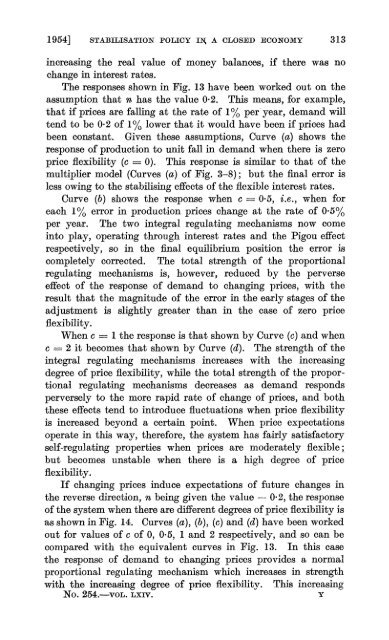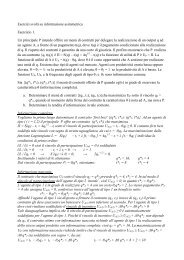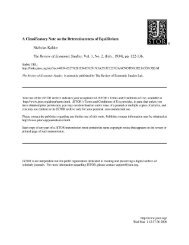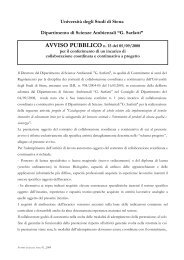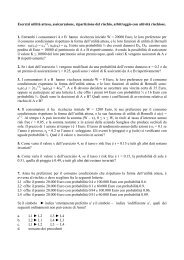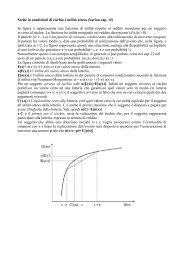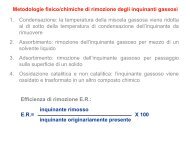Stabilisation Policy in a Closed Economy Author(s): A. W. Phillips ...
Stabilisation Policy in a Closed Economy Author(s): A. W. Phillips ...
Stabilisation Policy in a Closed Economy Author(s): A. W. Phillips ...
Create successful ePaper yourself
Turn your PDF publications into a flip-book with our unique Google optimized e-Paper software.
1954] STABILISATION POLICY IN, A CLOSED ECONOMY 313<br />
<strong>in</strong>creas<strong>in</strong>g the real value of money balances, if there was no<br />
change <strong>in</strong> <strong>in</strong>terest rates.<br />
The responses shown <strong>in</strong> Fig. 13 have been worked out on the<br />
assumption that n has the value 0-2. This means, for example,<br />
that if prices are fall<strong>in</strong>g at the rate of 1% per-year, demand will<br />
tend to be 0-2 of 1% lower that it would have been if prices had<br />
been constant. Given these assumptions, Curve (a) shows the<br />
response of production to unit fall <strong>in</strong> demand when there is zero<br />
price flexibility (c - 0). This response is similar to that of the<br />
multiplier model (Curves (a) of Fig. 3-8); but the f<strong>in</strong>al error is<br />
less ow<strong>in</strong>g to the stabilis<strong>in</strong>g effects of the flexible <strong>in</strong>terest rates.<br />
Curve (b) shows the response when c = 0.5, i.e., when for<br />
each 1% error <strong>in</strong> production prices change at the rate of 056%<br />
per year. The two <strong>in</strong>tegral regulat<strong>in</strong>g mechanisms now come<br />
<strong>in</strong>to play, operat<strong>in</strong>g through <strong>in</strong>terest rates and the Pigou effect<br />
respectively, so <strong>in</strong> the f<strong>in</strong>al equilibrium position the error is<br />
completely corrected. The total strength of the proportional<br />
regulat<strong>in</strong>g mechanisms is, however, reduced by the perverse<br />
effect of the response of demand to chang<strong>in</strong>g prices, with the<br />
result that the magnitude of the error <strong>in</strong> the early stages of the<br />
adjustment is slightly greater than <strong>in</strong> the case of zero price<br />
flexibility.<br />
When c = 1 the response is that shown by Curve (c) and when<br />
c = 2 it becomes that shown by Curve (d). The strength of the<br />
<strong>in</strong>tegral regulat<strong>in</strong>g mechanisms <strong>in</strong>creases with the <strong>in</strong>creas<strong>in</strong>g<br />
degree of price flexibility, while the total strength of the propor-<br />
tional regulat<strong>in</strong>g mechanisms decreases as demand responds<br />
perversely to the more rapid rate of change of prices, and both<br />
these effects tend to <strong>in</strong>troduce fluctuations when price flexibility<br />
is <strong>in</strong>creased beyond a certa<strong>in</strong> po<strong>in</strong>t. When price expectations<br />
operate <strong>in</strong> this way, therefore, the system has fairly satisfactory<br />
self-regulat<strong>in</strong>g properties when prices are moderately flexible;<br />
but becomes unstable when there is a high degree of price<br />
flexibility.<br />
If chang<strong>in</strong>g prices <strong>in</strong>duce expectations of future changes <strong>in</strong><br />
the reverse direction, n be<strong>in</strong>g given the value - 0-2, the response<br />
of the system when there are different degrees of price flexibility is<br />
as shown <strong>in</strong> Fig. 14. Curves (a), (b), (c) and (d) have been worked<br />
out for values of c of 0, 0.5, 1 and 2 respectively, and so can be<br />
compared with the- equivalent curves <strong>in</strong> Fig. 13. In this case<br />
the response of demand to chang<strong>in</strong>g prices provides a normal<br />
proportional regulat<strong>in</strong>g mechanism which <strong>in</strong>creases <strong>in</strong> strength<br />
with the <strong>in</strong>creas<strong>in</strong>g degree of price flexibility. This <strong>in</strong>creas<strong>in</strong>g<br />
No. 254.-VOL. LXIV. y


